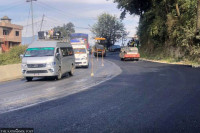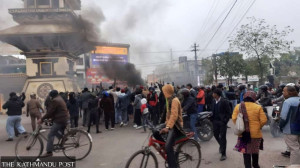National
Melamchi project headworks buried in mud, extent of damage unknown
Officials say the main tunnel was untouched, but other temporary structures have been swept by the floods, which could affect the water supply schedule in Kathmandu Valley.
Chandan Kumar Mandal
Tuesday’s destructive Melamchi flooding, attributed to a sudden bursting of the river blocked by landslides triggered by incessant rainfall, has caused significant damage to the Melamchi Water Supply Project.
The monsoon mayhem left behind a trail of devastation in Melamchi Municipality and nearby areas of Sindhupalchok district.
As floodwaters started gushing into settlements, hundreds of families were displaced in the Melamchi Bazar area, where the mud brought by the floodwaters buried homes as high as first the first floor.
Sindhupalchok district authorities, on Thursday afternoon, confirmed that three persons, including two Chinese and one Indian died, whereas 17 others, including two Indians and one Chinese, are still missing.
According to Rajendra Prasad Pant, spokesperson for the Melamchi Water Supply Development Board, which manages the project, the national pride project has suffered huge losses due to the flood.
“The flood, which is believed to have occurred due to landslides upstream, also affected the Melamchi project site. The flood brought mudflow that has buried the headworks site at Ambathan area,” said Pant, who is also a senior divisional engineer. “Most of the headworks area looks buried in debris. The right section of the headworks looks intact whereas the left section looks mostly buried in mud.”
Headworks include the structures constructed on the river for diverting the river water towards the tunnel or canal.
Besides the damage to the headworks structure, other temporary structures like camps for construction workers and concrete and Bailey bridges have been swept by the floods.
However, the Melamchi project authority has yet to fully estimate the scale of damage, which can run into several millions.
“We do not know the scale of damage caused to the headworks, which remain buried in mud, and other structures. It is not possible to calculate the loss until the floodwaters recede,” said Pant. “The floodwaters, however, have not caused any damage to the main tunnel, whose gates were closed.”
The main tunnel, which ferries water from the Melamchi river to the Kathmandu Valley, that lies nearly 800 metres from the headworks area has suffered damage. Before the 26.3-km main tunnel, there is a 298-metre adit tunnel—the gateway to the main tunnel.
The muddy water has blocked the entrance of the adit tunnel, according to Pant.
The flood has damaged a concrete bridge at the Ambathan adit and two other Bailey bridges, which were temporarily erected to support construction activities.
“Besides these structures, construction materials and other equipment stored at the camp have also been washed away by the floods. The electricity supply remains cut off,” said Pant. “Preliminary estimates show the loss is substantial.”
The flood has not only impacted the first phase of the Melamchi project, which aims to supply 170 million litres of drinking water daily to the Kathmandu Valley, but also the second phase of the project that plans to bring in an additional 170 million litres per day each from the Yangri and Larke rivers.
Access roads built along the Indrawati River for the phase 2 project have also been damaged and the construction of three bridges along the Dhap-Thulo Bhotang section have been affected. Construction materials and equipment meant for the construction of the bridges have been washed away.
The major obstacle in calculating the impact of the flood damage is the damaged roads that have made it difficult to reach the project site.
“Visiting the project site by road looks impossible at present,” said Pant. “Once the floodwaters recede, we will start repairing the roads. This means more resources are immediately required for road repair, which is going to take time.”
As many as 76 people were rescued from the campsite near the headworks area and brought to Kathmandu and Dhulikhel. According to a statement issued by the Melamchi Board, on Wednesday evening, at least eight workers are missing.
The Melamchi Water Supply Project had been lately working to complete the remaining work at the headworks site. For this, the project, which had already diverted the Melamchi water and started supplying to the Kathmandu Valley, on Tuesday, began flushing out the water from the tunnel for inspection.
Flushing out of the water started from Sundarijal side and blocked any more water inside the tunnel, which meant the closure of tunnel gates.
According to officials, the coincidental closing of gates hours before the floodwaters reached the project site averted damage that could have been even worse.
“We had hoped that the remaining work on the headworks would be completed within a two-month period, which we have set for inspecting the tunnel,” said Pant. “Had the floodwaters entered the main tunnel, it would have been blocked by mud and cleanup would take several months. The cleanup work would be even more difficult as the contractors have already taken away the heavy equipment, which could require nearly six months to assemble.”
As per the plan, in the two-month period, the water from the tunnel would be released first from the Sundarijal site and then from Gyalthum and Ambathan. Currently, 200 litres of water per second is being released from Sundarijal.
Once all the water has been flushed out from the tunnel, followed by an inspection by experts, and completion of remaining work at the headworks site, the government planned to regularly supply Melamchi water to household taps in the Kathmandu Valley.
The havoc caused by the flood could affect the entire schedule, according to Pant.
The Board has been consulting experts to discuss the way ahead.
“If we are able to repair the road to the project site and remove the mud piled up by the flood in the next two months, then the supply schedule will not be affected significantly,” said Pant. “However, as the headworks area itself is buried under debris, we are yet to determine the extent of damage. So it remains uncertain how long the whole process will take.”




 6.84°C Kathmandu
6.84°C Kathmandu








%20(1).jpg&w=300&height=200)






